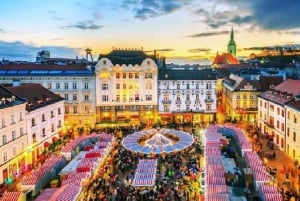
From Vienna: Private Day Tour of Devin Castle & Bratislava
2 ReviewsExplore beutiful Slovakian capital Bratislava, with a local tour guide
The construction of the basilica in years 1739 – 1741 was arranged by archbishop Imrich Eszterházy.
Virgin Mary of Trnava is a copy of the painting from the Basilica of St. Boniface and St. Alexius in Rome. The tradition says that St. Alexius left Rome for Syria and lived there as a hermit. After many years he returned from Syria with a painting of Virgin Mary and lived in Rome beneath the staircase of the house of his parents. After his death, his parents finally learned that it was their son. They built a chapel there and placed the painting in the chapel. Later on, a church was constructed over the grave of St. Alexius.
It is assumed that the elaboration of the copy located in Trnava was arranged by the to-be cardinal Francis Forgách during his studies. After his return in 1585, he placed the painting in the St. Nicolas Basilica.
In 1663, blood tears appeared on the painting. Then, Hungary was under the Turkish menace; however, the Turks did not attack Trnava, though they plundered the surrounding. The painting wept three times during the Kuruc (anti-Habsburg) war in 1708, specifically on July 5, August 10 and August 11. Then, a commission was established to investigate the 'weeping case'. Based on the results of the investigation, Archbishop of Esztergom Kristián August approved public worship to the painting of Virgin Mary of Trnava on 19 December 1708. In 1710, there was plague in Trnava. When all human means failed, helpless people of the town headed by the town council appealed to Virgin Mary for help. They made a vow to celebrate, after a preceding period of fasting, the Blessed Virgin Mary and to serve a holy mass at the blessed painting. They prepared a deed in memory of this fact. They prayed, fasted and on 21 November 1710, on the Day of Blessed Virgin Mary, they took the painting and walked with it in the streets. On that day the plague miraculously ended.
The worshiping of Virgin Mary later on underwent periods of bloom and periods of lack of interest. After years of decline, the worshiping was revived in 1940s when a new tradition of novena was established. Nowadays, believers visit the painting to ask for God's help and to thank for the grace bestowed.
Instant Booking Confirmation
Book NowTrnava Tourist Information Centre (TINS), Trojičné námestie 1, Lower-Povazie, 917 01
View Larger MapMy Guide Slovakia is part of the global My Guide Network of Online & Mobile travel guides.
We are now in 120+ Destinations and Growing. If you are interested in becoming a local travel partner and would like to find out more then click for more info about our Website Business Opportunity.
Filter Events by Sub-Category
Please select a Date first.